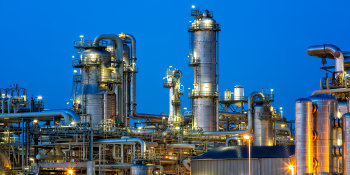A proposed methanol plant in Washington State could increase global greenhouse gas emissions and is likely inconsistent with a low-carbon future, according to a new report from the Stockholm Environment Institute.

A petrochemical plant at twilight. Photo credit: Getty/B&M Noskowski
The report raises serious questions about the claims that the facility would reduce global greenhouse gas (GHG) emissions and details the deficiencies in the project’s Final Environmental Impact Statement (EIS). It comes as a Supplemental EIS aims to fix prior flaws.
SEI researchers found that the facility – proposed for development in the Port of Kalama – could result in emissions that are two to six times higher than the final EIS estimate. That’s largely because the EIS left out emissions from the natural gas supply to the plant.
“The final EIS defies good practice for assessing a facility’s emissions impact,” said SEI Senior Scientist Peter Erickson, a co-author of the report. “The new analysis provides an opportunity to fix that, and consider all emission impacts in the supplemental review.”
The proposed facility would use natural gas sourced from other states and provinces in the western U.S. and Canada to produce methanol, which would then be shipped to China to produce olefins (or plastics). A state board rejected the facility’s permit last year, citing insufficient analysis of the GHG emissions impact.
The new Supplemental EIS is in response to the board’s order that the Port of Kalama and Cowlitz County conduct additional research. The board – called the Shoreline Hearings Board – has asked that the supplemental review include estimates of the emissions from the production and transportation of natural gas used to produce the plant’s methanol.
Today’s report confirms that those emissions are substantial. It also casts doubt on claims that the plant would replace coal-based methanol plants in China and thus benefit the climate.
Researchers found that the Kalama facility is just as likely to displace more common – and less emissions-intensive – methods to produce plastics.
“Coal-based methanol is indeed emissions-intensive – but it shouldn’t be assumed that’s what Kalama’s output would displace,” said Michael Lazarus, the Center Director of SEI’s U.S. Center and a co-author of the report. “The more common and lower-emissions way to make plastics is based on naphtha or ethane instead of methanol.”
The SEI report analyzes the emissions of the Kalama facility as part of a broader look at industry’s role in a low-carbon economy. Researchers propose a “climate test” for policymakers to assess new industrial development. This test would consider both greenhouse gas emissions and whether a new facility would “lock in” technology inconsistent with a low-carbon future.
For interviews and further information, please contact:
Design and development by Soapbox.